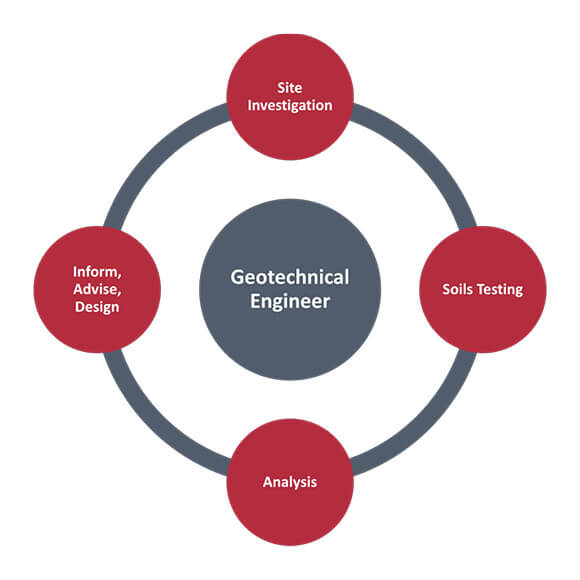The Main Principles Of Geotechnical Engineering For Construction Projects
The Main Principles Of Geotechnical Engineering For Construction Projects
Blog Article
The Buzz on Geotechnical Engineering For Construction Projects
Table of ContentsThe Ultimate Guide To Geotechnical Engineering For Construction ProjectsGeotechnical Engineering For Construction Projects Fundamentals ExplainedWhat Does Geotechnical Engineering For Construction Projects Do?Not known Facts About Geotechnical Engineering For Construction ProjectsNot known Facts About Geotechnical Engineering For Construction Projects
Consequently, throughout the examination, it is very important to drill at the required deepness and the needed number of openings according to the suggestion of the Canadian Foundation Layout requirement. In some cases, the owner may conserve some Geotechnical Examination price however finish up investing greater than the expected during the building expense.The obligations of the geotechnical specialist entail giving material screening for construction support. Geotechnical Engineering for Construction Projects. Geotechnical designers evaluate all the field examination records to make certain that building and construction is taking place based on the task spec. During building and construction, a confirmatory examination for dirt compaction is done on-site to make certain that no future negotiation happens
After the concrete is poured -7 days and 28 days- tests are performed on concrete samples gathered from the site to make certain that the concrete put meets the style requirement. Asphalt core is taken after the Asphalt is laid and compressed to verify that it fulfills the layout requirement. All research laboratory test reports are evaluated by the Geotechnical Engineer to guarantee that it fulfills the project requirements.
Getting My Geotechnical Engineering For Construction Projects To Work

Geotechnical engineering plays an essential role in making sure the security of building and construction jobs. Geotechnical engineering is an important branch of civil engineering that focuses on understanding the behavior of earth products, such as soil and rock.

For a trusted structure and a smooth building procedure, depend supply the experience you need. Call to obtain professional suggestions and geotechnical services customized to your following job.
The Single Strategy To Use For Geotechnical Engineering For Construction Projects
When starting a land advancement job, recognizing the ground underneath your feet is as important as the structures you intend to develop over it. Our Geotechnical Design group evaluate the ground, ensuring it appropriates for the proposed development while providing you with the details needed to meet your task objectives.
Geotechnical Design checks out the formation of the ground, as it is the building blocks for all tasks. Where frameworks need to be created with regard to the ground conditions; ground conditions (e.g., soft ground) may call for strengthening depending on the size of the designated framework. Prior to structure, you need to find out about the groundwater, dirt framework, and liquefaction possibility of your land.
For websites that are not attached on the local authority facilities extra website examinations would be required to supply technological inputs for on-site stormwater and wastewater. We have actually experienced Geotechnical Designers based in each workplace, sustaining your geotechnical needs nationwide. Connect to us to go over just how we use this link can sustain your following project.
These reports are tailored to meet the particular requirements of a job and consist of style specifications and suggestions for the building of a variety of synthetic frameworks. As supplying consultancy services covering areas such as slope security and load-bearing abilities for various materials, these engineers carry out research study and development activities to improve methodologies, devices, materials understanding and analysis covering entire lifecycles.
Things about Geotechnical Engineering For Construction Projects

Nonetheless, prices of pay typically increase as your understanding and skills grow, with guidelines indicating a graduate beginning salary of in between 18,000 and 28,000 each year in the UK. This increases to 26,000 to 36,000 with a couple of years of experience and afterwards getting to 40,000 to 60,000+ for elderly, chartered or master designers.
Nevertheless, with the best application it is possible to understand the occupation and gain entry to a challenging yet rewarding and crucial occupation. A geologist would certainly require to retrain to end up being a geotechnical designer, although there is lots of cross-over between both careers, which could make this easier - Geotechnical Engineering for Construction Projects. Rock hounds require to have an understanding of soils, rocks and various other materials from a clinical perspective, while geotechnical engineers story their expertise of issues such as dirt and rock mechanic, geophysics and hydrology and apply them to engineering and environmental jobs
When starting, these designers will certainly tend to function on less complex jobs, developing understanding and experience all set for even more challenging work later on. Geotechnical engineers tend to specialise in specific areas as they expand in experience, concentrating on specific facilities such as trains, roads or water. These designers likewise function with renewable resource, offshore and onshore oil and gas, nuclear power, and extra.
Get This Report about Geotechnical Engineering For Construction Projects
The moment required to come to be a geotechnical designer depends upon where you are based, where you study and what degree of education and learning you wish to attain prior to going into the workplace. Are you going to explore an instruction, take an university level or work with useful content in the direction of a Master's or PhD? Generally-speaking it takes 3-4 years to reach the standard demands to start a profession as a geotechnical designer.
These operations enable experts to analyze a host of dirt mechanics consisting of weight, porosity, void-to-solid fragment ratio, leaks in the structure, compressibility, maximum shear stamina, bearing capability and deformations. If the framework requires a deep structure, engineers will use a cone infiltration examination to approximate the amount of skin and end bearing resistance in the subsurface.
When evaluating an incline's equilibrium of shear anxiety and shear toughness, or its ability to hold up against and undergo motion, rotational slides and translational slides are typically considered. Rotational slides fall short along a bent surface, with translational slides taking place on a planar surface area. A professional's goal is to establish the conditions at which an incline failure could happen.
Frequently, searchings for recommend that a site's dirt must be dealt with to boost its shear strength, stiffness and permeability prior to design and building and construction. When it comes time to outline structure strategies, experts are increasingly focused on sustainability, more specifically how to decrease a foundation's carbon footprint. One strategy has been to change 20 percent of a structure's cement with fly ash, a waste item from go to this website coal fire power plants.
Report this page